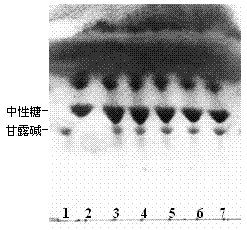Method for inducing Polygonum ciliinerve to generate hairy roots
A technique for hairy roots and Polygonum trichomes, which is applied in the field of inducing Polygonum triclosanus to produce hairy roots, and achieves the effects of high proliferation coefficient, convenient material collection, and short culture time.
- Summary
- Abstract
- Description
- Claims
- Application Information
AI Technical Summary
Problems solved by technology
Method used
Image
Examples
Embodiment 1
[0032] Example 1: Polygonum trichotilloides hairy root induction
[0033] 1. Bacterial strains and culture After dark culture of Agrobacterium rhizogenes W.T15834 on YEB solid medium, pick a single colony, activate at 25°C, 28°C, 200 r / min dark shaking culture for 12h, transfer to fresh YEB liquid culture culture medium to OD 600 When it is 0.6, it is used for infection.
[0034] 2. Preparation of explants The young leaves of 20-day-old aseptic seedlings of Polygonum trichotilloide were cut into about 1.0 cm 2 Petiole-free leaf explants were placed on MS solid medium and pre-cultured for 24 hours for transformation.
[0035] 3. Induction, transformation and induction of hairy roots: immerse the explants of Polygonum trichophyllum leaf explants pre-cultured for 24 hours in the suspension of Agrobacterium rhizogenes W.T15834 diluted 5 times with MS medium and shake gently for 10 minutes, take out For the explants, use sterile filter paper to suck off the excess bacterial solu...
Embodiment 2
[0037] Example 2: Detection of mannoline in the hairy roots of Polygonum trichotilloides
[0038] The roots of non-transformed plants were used as the negative control, and the mannopine standard (1.02 mg / m / L) was used as the positive control. Referring to the method of Wang Guanlin et al., the mannopine in the transformed hairy roots was detected. The gene encoding opine synthase in the Ri plasmid TR-DNA (T-DNA right arm) region of Agrobacterium rhizogenes W.T15834 can be integrated into the Genomic DNA of Polygonum trichotilloides and expressed in Polygonum trichophyllum cells Specific product mannoline ( figure 2 ).
Embodiment 3
[0039] Embodiment 3: PCR detection of the hairy roots of Polygonum trichotilloides
[0040] 1. Plant DNA extraction: extract hairy root DNA with micro-CTAB method, use non-transformed plant hairy root total DNA as a control, and use it as a template for PCR amplification after purification.
[0041] 2. Extraction of Ri plasmid DNA from Agrobacterium rhizogenes: Take 200 μl of activated Agrobacterium rhizogenes strain W.T15834, centrifuge at 6000 r / min for 5 minutes, collect the precipitated bacteria, add 40 μl of lysate (Shanghai Sangong Technology Co., Ltd.), Suspend and mix well, lyse at 94°C for 15 minutes, centrifuge at 13,000 r / min for 5 minutes, and take the supernatant for later use. And take a small amount of supernatant to measure its OD 600 The value is 0.6.
[0042] 3. PCR reaction: 20 μL of reaction system, including 1 μg of DNA template, 1 μL of each upstream and downstream primers (final concentration 20 pmol / L), the primers used were based on the genes related...
PUM
 Login to View More
Login to View More Abstract
Description
Claims
Application Information
 Login to View More
Login to View More - R&D
- Intellectual Property
- Life Sciences
- Materials
- Tech Scout
- Unparalleled Data Quality
- Higher Quality Content
- 60% Fewer Hallucinations
Browse by: Latest US Patents, China's latest patents, Technical Efficacy Thesaurus, Application Domain, Technology Topic, Popular Technical Reports.
© 2025 PatSnap. All rights reserved.Legal|Privacy policy|Modern Slavery Act Transparency Statement|Sitemap|About US| Contact US: help@patsnap.com



